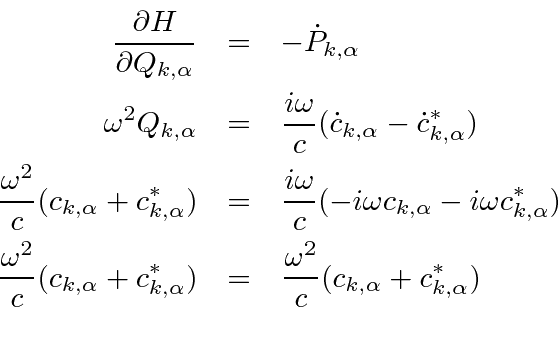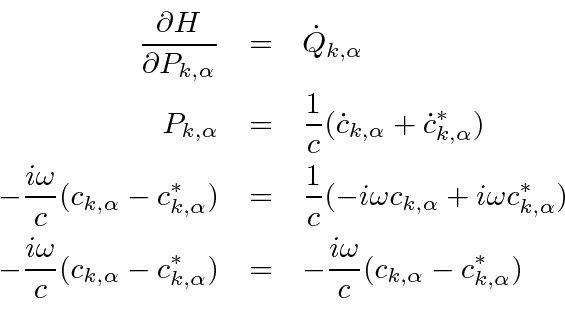Next: Quantization of the Oscillators Up: Quantum Theory of Radiation Previous: The Hamiltonian for the Contents
We now have the Hamiltonian for the radiation field.
![\bgroup\color{black}$\displaystyle H=\sum\limits_{k,\alpha}\left({\omega\over c}...
..._{k,\alpha}(t)c_{k,\alpha}^*(t)+c_{k,\alpha}^*(t)c_{k,\alpha}(t)\right] $\egroup](img3916.png) |
 to be the time dependent Fourier coefficient.
to be the time dependent Fourier coefficient.

![\begin{displaymath}\bgroup\color{black} H=\sum\limits_{k,\alpha}\left({\omega\ov...
...\alpha}c_{k,\alpha}^*+c_{k,\alpha}^*c_{k,\alpha}\right] \egroup\end{displaymath}](img3918.png)
We wish to write the Hamiltonian in terms of a coordinate for each oscillator and the conjugate momenta.
The coordinate should be real so it can be represented by a Hermitian operator and have a physical meaning.
The simplest choice for a real coordinates is
 .
With a little effort we can identify the coordinate
.
With a little effort we can identify the coordinate


![\begin{eqnarray*}
H&=&{1\over 2}\sum\limits_{k,\alpha}\left[P_{k,\alpha}^2+\omeg...
...c_{k,\alpha}c_{k,\alpha}^*+c_{k,\alpha}^*c_{k,\alpha}\right] \\
\end{eqnarray*}](img3921.png)

The other equation of Hamilton is

We have a collection of uncoupled oscillators with identified canonical coordinate and momentum. The next step is to quantize the oscillators.
Jim Branson 2013-04-22